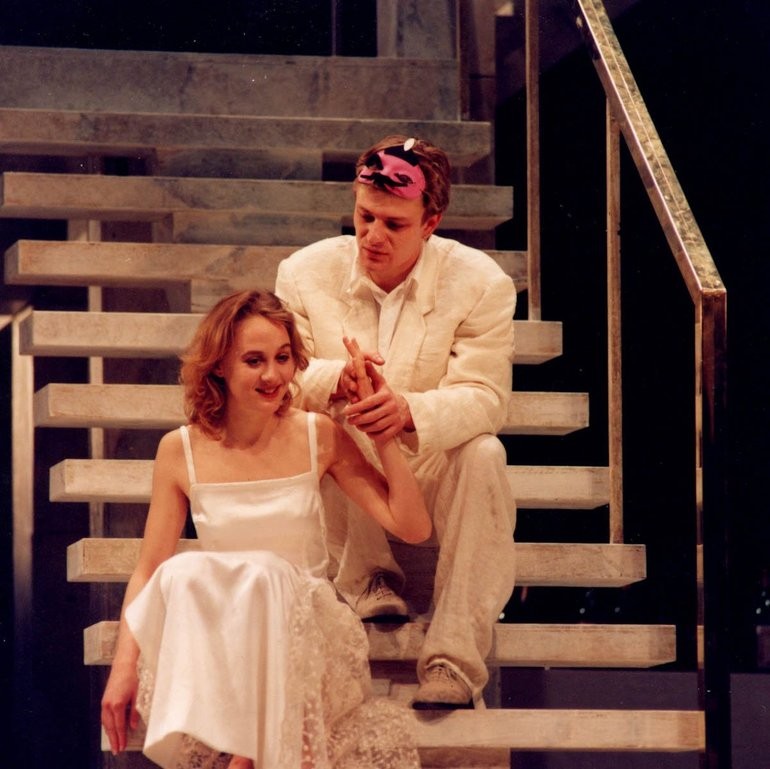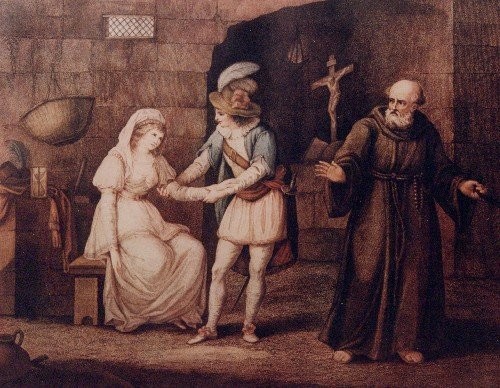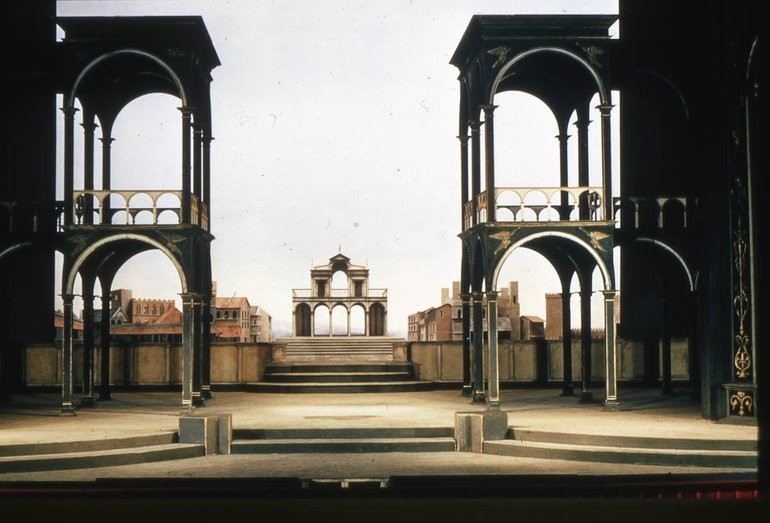What Is Romeo And Juliet About? Romeo and Juliet, a poignant play penned by William Shakespeare, explores themes of love, death, tragedy, and familial conflict. At WHAT.EDU.VN, we help you understand every facet of this timeless play. Discover the nuances of this tragic love story and explore related themes.
1. Introduction to Romeo and Juliet
Romeo and Juliet is a tragedy written by William Shakespeare about two young star-crossed lovers whose deaths ultimately reconcile their feuding families. It’s one of Shakespeare’s most popular and frequently performed plays. The play explores themes such as passionate love, the dangers of hate, the power of fate, and the tragedy of youthful impulsiveness. Want to explore similar themes or need help understanding the play better? At WHAT.EDU.VN, we provide a platform for all your questions and curiosities.
2. The Core Narrative of Romeo and Juliet
The play revolves around Romeo Montague and Juliet Capulet, who fall deeply in love despite their families’ bitter and long-standing feud. Their love is passionate and immediate, leading them to secretly marry. However, their union is quickly threatened by escalating violence between their families. Looking for a deeper dive into specific parts of the narrative? Feel free to ask questions at WHAT.EDU.VN.
2.1 Key Events Driving the Plot
- The Capulet Feast: Romeo and his friends attend a Capulet party in disguise, where Romeo meets Juliet.
- The Balcony Scene: Romeo and Juliet declare their love for each other from Juliet’s balcony.
- The Secret Marriage: Friar Laurence secretly marries Romeo and Juliet, hoping to reconcile the two families.
- Tybalt’s Death: Romeo attempts to stop a fight between Tybalt (Juliet’s cousin) and Mercutio, but Mercutio is killed. In a fit of rage, Romeo kills Tybalt, leading to his banishment from Verona.
- Juliet’s Predicament: Juliet is forced to marry Paris, a nobleman chosen by her parents.
- The Friar’s Plan: To avoid the marriage, Friar Laurence gives Juliet a potion that will make her appear dead for 42 hours. He plans to inform Romeo so he can retrieve her when she awakens.
- Romeo’s Tragedy: Romeo doesn’t receive the message about Juliet’s fake death. Hearing only of her death, he buys poison and goes to her tomb.
- The Double Suicide: Romeo kills Paris, who is mourning at Juliet’s tomb, then drinks the poison and dies. Juliet awakens to find Romeo dead and kills herself with his dagger.
3. Exploring the Main Themes
Romeo and Juliet is rich with thematic content that resonates even today. Here’s a breakdown of some key themes:
3.1 Love
Love is the most obvious theme, portrayed as both a powerful and destructive force. Romeo and Juliet’s love is intense, passionate, and immediate, leading them to defy their families and societal expectations.
3.2 Hate and Violence
The bitter feud between the Montagues and Capulets fuels much of the tragedy. The senseless hatred leads to violence, death, and ultimately, the demise of the young lovers.
3.3 Fate
Fate plays a significant role in the play. Romeo and Juliet are described as “star-crossed lovers,” suggesting that their destiny is predetermined and tragic.
3.4 Death
Death is ever-present in the play. It serves as the ultimate consequence of the families’ hatred and the lovers’ impetuous actions. Romeo and Juliet’s deaths are seen as the only way to end the feud.
3.5 Youth and Impulsiveness
Romeo and Juliet are young and make rash decisions based on their emotions. Their impulsiveness contributes to the tragic outcome of the play. Need to understand how these themes interconnect? WHAT.EDU.VN is here to help with detailed explanations and analyses.
4. Character Analysis
Understanding the main characters is crucial to grasping the full impact of the story:
4.1 Romeo Montague
Romeo is a passionate and impulsive young man from the Montague family. Initially lovesick for Rosaline, he quickly falls deeply in love with Juliet.
4.2 Juliet Capulet
Juliet is a young, beautiful, and intelligent girl from the Capulet family. She is equally passionate and devoted to Romeo.
4.3 Friar Laurence
A well-intentioned friar who hopes to end the feud between the Montagues and Capulets by marrying Romeo and Juliet. He is a trusted advisor to both Romeo and Juliet.
4.4 Mercutio
Romeo’s close friend, known for his wit and flamboyant personality. His death at the hands of Tybalt sets off a chain of tragic events.
4.5 Tybalt
Juliet’s cousin, a hot-headed and skilled swordsman. He is fiercely loyal to the Capulet family and hates the Montagues.
4.6 The Nurse
Juliet’s caregiver and confidante. She is a source of comic relief but also plays a key role in facilitating Romeo and Juliet’s relationship.
5. Act-by-Act Breakdown
To fully understand the play, let’s break down the key events in each act:
5.1 Act I
The play opens with the Chorus setting the scene and introducing the feud. Romeo is introduced as a lovesick young man pining for Rosaline. The Capulet family prepares for a feast. Romeo and his friends decide to attend the feast in disguise. Romeo meets Juliet and they fall in love instantly.
5.2 Act II
Romeo and Juliet declare their love for each other in the famous balcony scene. They decide to get married and enlist the help of Friar Laurence and Juliet’s Nurse. The act culminates in their secret marriage.
5.3 Act III
Tybalt challenges Romeo to a duel. Romeo refuses to fight, but Mercutio steps in and is killed by Tybalt. In a fit of rage, Romeo kills Tybalt, leading to his banishment from Verona. Juliet is devastated by the news. Friar Laurence helps Romeo and Juliet spend one last night together before Romeo flees to Mantua. Lord Capulet arranges for Juliet to marry Paris.
5.4 Act IV
Juliet seeks Friar Laurence’s help to avoid marrying Paris. He gives her a sleeping potion that will make her appear dead. The Capulets find Juliet “dead” on her wedding day. Friar Laurence sends a messenger to inform Romeo of the plan.
5.5 Act V
Romeo doesn’t receive the message about Juliet’s fake death. Hearing only of her death, he buys poison and returns to Verona. He goes to Juliet’s tomb, where he encounters and kills Paris. Romeo drinks the poison and dies. Juliet awakens to find Romeo dead and kills herself with his dagger. The Montagues and Capulets arrive and, witnessing the tragedy, finally reconcile.
6. Famous Quotes from Romeo and Juliet
The play is filled with memorable lines that capture the essence of its themes:
6.1 “But, soft! what light through yonder window breaks? It is the east, and Juliet is the sun.”
– Romeo, Act II, Scene II
This quote expresses Romeo’s awe and admiration for Juliet.
6.2 “O Romeo, Romeo! wherefore art thou Romeo? Deny thy father and refuse thy name; Or, if thou wilt not, be but sworn my love, And I’ll no longer be a Capulet.”
– Juliet, Act II, Scene II
Juliet laments Romeo’s identity as a Montague, wishing that their families weren’t enemies.
6.3 “What’s in a name? That which we call a rose by any other name would smell as sweet.”
– Juliet, Act II, Scene II
Juliet reflects on the insignificance of names, suggesting that Romeo would be just as wonderful regardless of his family name.
6.4 “Parting is such sweet sorrow, That I shall say good night till it be morrow.”
– Juliet, Act II, Scene II
This quote captures the bittersweet feeling of saying goodbye, knowing that they will meet again soon.
6.5 “For never was a story of more woe than this of Juliet and her Romeo.”
– Prince, Act V, Scene III
The Prince summarizes the tragic tale, emphasizing the immense sorrow caused by the feud. Want to know more about the context of these quotes? WHAT.EDU.VN can provide detailed explanations and analyses.
7. The Historical Context of Romeo and Juliet
Understanding the historical context can enhance your appreciation of the play:
7.1 Elizabethan England
Romeo and Juliet was written during the Elizabethan era, a time of great social and political change in England. Shakespeare’s plays often reflected the values and concerns of his time.
7.2 Family Feuds
Feuds between families were common in Renaissance Italy, the setting of Romeo and Juliet. These conflicts often led to violence and bloodshed.
7.3 Social Hierarchy
The play reflects the rigid social hierarchy of the time, with characters’ status influencing their roles and relationships.
7.4 Belief in Fate
The Elizabethan era was a time when many people believed in fate and astrology. This belief is reflected in the play’s emphasis on Romeo and Juliet as “star-crossed lovers.” Curious about other historical influences? Ask your questions at WHAT.EDU.VN for insightful answers.
8. Romeo and Juliet in Popular Culture
Romeo and Juliet has had a lasting impact on popular culture, inspiring countless adaptations and references:
8.1 Film Adaptations
There have been numerous film adaptations of Romeo and Juliet, including:
- Romeo and Juliet (1968): Directed by Franco Zeffirelli, known for its romantic and faithful portrayal of the play.
- Romeo + Juliet (1996): Directed by Baz Luhrmann, a modern adaptation set in Verona Beach, featuring Leonardo DiCaprio and Claire Danes.
- Gnomeo & Juliet (2011): An animated film featuring garden gnomes in the roles of Romeo and Juliet.
8.2 Stage Productions
Romeo and Juliet remains one of Shakespeare’s most frequently performed plays, with countless stage productions around the world.
8.3 Literary References
The story of Romeo and Juliet has inspired numerous literary works, including novels, poems, and short stories.
8.4 Music
The play has inspired many musical compositions, including:
- Romeo and Juliet, Op. 64 (1936): A ballet by Sergei Prokofiev.
- West Side Story (1957): A musical by Leonard Bernstein, a modern adaptation of Romeo and Juliet set in New York City.
8.5 Television
Many television shows have referenced or adapted elements of Romeo and Juliet in their storylines.
9. Why Romeo and Juliet Still Matters Today
Despite being written centuries ago, Romeo and Juliet continues to resonate with audiences today:
9.1 Universal Themes
The play explores timeless themes such as love, hate, fate, and death, which are relevant to people of all ages and cultures.
9.2 Emotional Impact
The tragic story of Romeo and Juliet evokes strong emotions in audiences, reminding us of the power of love and the consequences of hatred.
9.3 Enduring Appeal
The play’s beautiful language, compelling characters, and dramatic plot continue to captivate audiences and inspire new interpretations.
9.4 Relevance to Modern Issues
Romeo and Juliet’s themes of conflict and prejudice are still relevant in today’s world, making the play a powerful commentary on social issues.
10. FAQs About Romeo and Juliet
Here are some frequently asked questions about the play:
10.1 What is the main conflict in Romeo and Juliet?
The main conflict is the feud between the Montague and Capulet families, which prevents Romeo and Juliet from being together.
10.2 What is the role of fate in Romeo and Juliet?
Fate plays a significant role, as Romeo and Juliet are described as “star-crossed lovers,” suggesting that their destiny is predetermined and tragic.
10.3 Why do Romeo and Juliet kill themselves?
Romeo kills himself because he believes Juliet is dead. Juliet kills herself because she awakens to find Romeo dead and cannot bear to live without him.
10.4 What is the significance of the ending of Romeo and Juliet?
The ending is significant because the deaths of Romeo and Juliet finally reconcile the feuding families, bringing an end to their long-standing hatred.
10.5 How does Shakespeare use language in Romeo and Juliet?
Shakespeare uses rich and poetic language to convey the emotions and themes of the play. He employs metaphors, similes, and other literary devices to create vivid imagery and enhance the dramatic impact.
10.6 What are some of the key symbols in Romeo and Juliet?
Key symbols include light and darkness, poison, and flowers, each representing different aspects of the play’s themes.
10.7 Who is to blame for the deaths of Romeo and Juliet?
Many characters could be blamed, including the feuding families, Tybalt, and even Friar Laurence, but ultimately, the tragedy is a result of a combination of factors.
10.8 What is the moral of Romeo and Juliet?
The moral of the story is often interpreted as a warning against the destructive nature of hatred and the importance of love and understanding.
10.9 How does Romeo and Juliet reflect the values of Elizabethan England?
The play reflects the values of Elizabethan England through its depiction of social hierarchy, belief in fate, and emphasis on family honor.
10.10 What makes Romeo and Juliet a tragedy?
Romeo and Juliet is a tragedy because it tells the story of two noble characters who are ultimately brought down by their own flaws and external forces, leading to their deaths.
11. Romeo and Juliet Summary – Act by Act
| Act | Summary |
|---|---|
| Act I | Introduction of the Montague and Capulet families, their ongoing feud, and Romeo’s initial infatuation with Rosaline. Romeo and Juliet meet at the Capulet feast and fall in love. |
| Act II | Romeo and Juliet declare their love in the balcony scene and decide to marry. With the help of Friar Laurence and the Nurse, they secretly wed. |
| Act III | Tybalt kills Mercutio, leading Romeo to kill Tybalt in revenge. Romeo is banished by the Prince. Juliet is distraught by the news. Lord Capulet arranges for Juliet to marry Paris. |
| Act IV | Juliet seeks Friar Laurence’s help to avoid marrying Paris. He gives her a potion to feign death. The Capulets find Juliet seemingly dead on her wedding day. Friar Laurence sends a messenger to inform Romeo. |
| Act V | Romeo doesn’t receive the message and hears only of Juliet’s death. He buys poison, returns to Verona, and kills Paris at Juliet’s tomb. Romeo drinks the poison and dies. Juliet awakens, finds Romeo dead, and kills herself with his dagger. The Montagues and Capulets arrive and reconcile, ending their feud. |



12. Understanding Romeo and Juliet’s Relevance Today
To truly understand “what is Romeo and Juliet about”, it’s important to understand why it still resonates today. This play remains relevant due to its exploration of themes that continue to affect modern society. The tragic consequences of hatred, the overwhelming power of love, and the impact of impulsive decisions are all elements that reflect contemporary issues. By studying the play, audiences can gain insight into conflict resolution, empathy, and the importance of understanding differing perspectives.
13. Deeper Analysis of Key Scenes
13.1 The Balcony Scene (Act II, Scene II)
One of the most iconic scenes in literature, the balcony scene showcases Romeo and Juliet’s raw, unfiltered emotions as they express their love for one another. This scene highlights the theme of love conquering all obstacles, as they disregard their families’ feud and societal expectations.
13.2 The Death Scene (Act V, Scene III)
The final scene in Juliet’s tomb encapsulates the play’s tragic essence. Romeo’s misunderstanding and subsequent suicide, followed by Juliet’s despair and self-inflicted death, underscore the devastating consequences of miscommunication and unchecked emotions. It also serves as a catalyst for reconciliation between the warring families.
14. Expanding Knowledge on “What is Romeo and Juliet About”
14.1 Further Reading and Resources
- Shakespearean Criticism: Exploring critical essays and analyses on “Romeo and Juliet” can provide deeper insights into its themes, characters, and historical context.
- Scholarly Articles: Researching academic papers can offer diverse interpretations and perspectives on the play’s significance.
- Online Forums and Discussions: Engaging with other enthusiasts in online forums can broaden understanding and stimulate critical thinking about “Romeo and Juliet.”
14.2 Understanding the Symbolism in Romeo and Juliet
Shakespeare uses symbolism throughout “Romeo and Juliet” to enhance the play’s themes and emotional impact. Light and darkness symbolize love and hate, hope and despair, and knowledge and ignorance. Poison symbolizes deception, danger, and the destructive nature of revenge. Flowers symbolize beauty, youth, and the transience of life. By recognizing these symbols, readers and viewers can gain a deeper understanding of the play’s message and emotional depth.
14.3 Romeo and Juliet: Understanding Literary Devices
Understanding the literary devices used by Shakespeare can greatly enhance your appreciation of the play. Some of the key devices include:
- Metaphor: Comparing two unlike things without using “like” or “as.”
- Simile: Comparing two unlike things using “like” or “as.”
- Irony: The use of words to convey a meaning that is the opposite of its literal meaning.
- Foreshadowing: Hints or clues about events that will occur later in the story.
By identifying these devices, readers and viewers can gain a deeper understanding of the play’s artistry and emotional impact.
15. Delving Deeper into Interpretations and Analysis
15.1 “Romeo and Juliet” as a Cautionary Tale
One common interpretation of “Romeo and Juliet” is as a cautionary tale about the destructive power of hatred and prejudice. The senseless feud between the Montagues and Capulets leads to the deaths of the young lovers, highlighting the devastating consequences of unchecked animosity. This interpretation encourages audiences to reflect on the importance of empathy, understanding, and reconciliation in their own lives.
15.2 “Romeo and Juliet” as a Tragedy of Fate
Another perspective views “Romeo and Juliet” as a tragedy of fate, where the characters are victims of circumstances beyond their control. The play suggests that the lovers are destined for tragedy from the beginning, as they are described as “star-crossed.” This interpretation raises questions about free will versus determinism and the role of destiny in shaping human lives.
15.3 “Romeo and Juliet” as a Reflection of Societal Norms
“Romeo and Juliet” can also be seen as a reflection of societal norms and values in Elizabethan England. The play critiques the rigid social hierarchy, the emphasis on family honor, and the limited roles available to women. By examining these aspects of the play, audiences can gain insights into the historical context in which it was written and its commentary on contemporary issues.
16. The Enduring Power of Romeo and Juliet
What is Romeo and Juliet about? It’s about a story that transcends time and culture, exploring universal themes of love, hate, fate, and death. Its enduring appeal lies in its ability to evoke strong emotions, challenge societal norms, and inspire reflection on the human condition. Whether you’re a student, a literature enthusiast, or simply curious about this timeless tale, “Romeo and Juliet” offers a wealth of insights and emotional resonance that will stay with you long after the final curtain falls.
17. Need More Answers? Ask WHAT.EDU.VN!
Still have questions about Romeo and Juliet? Don’t hesitate to ask! At WHAT.EDU.VN, we provide a platform for all your queries. Whether you’re struggling with understanding a particular scene, analyzing a character, or exploring the play’s themes, our community is here to help.
17.1 How WHAT.EDU.VN Can Help You
- Free Answers: Get quick and reliable answers to any question about Romeo and Juliet.
- Community Support: Connect with other students, teachers, and literature enthusiasts to discuss the play and share insights.
- Expert Explanations: Access detailed explanations and analyses of key scenes, characters, and themes.
17.2 Get in Touch
Have questions or need assistance? Contact us today:
- Address: 888 Question City Plaza, Seattle, WA 98101, United States
- WhatsApp: +1 (206) 555-7890
- Website: WHAT.EDU.VN
18. Call to Action
Don’t let your questions about Romeo and Juliet go unanswered! Visit what.edu.vn now to ask your questions and get the answers you need. Our free platform makes it easy to explore this timeless tragedy and deepen your understanding. Join our community today and discover the power of knowledge.
